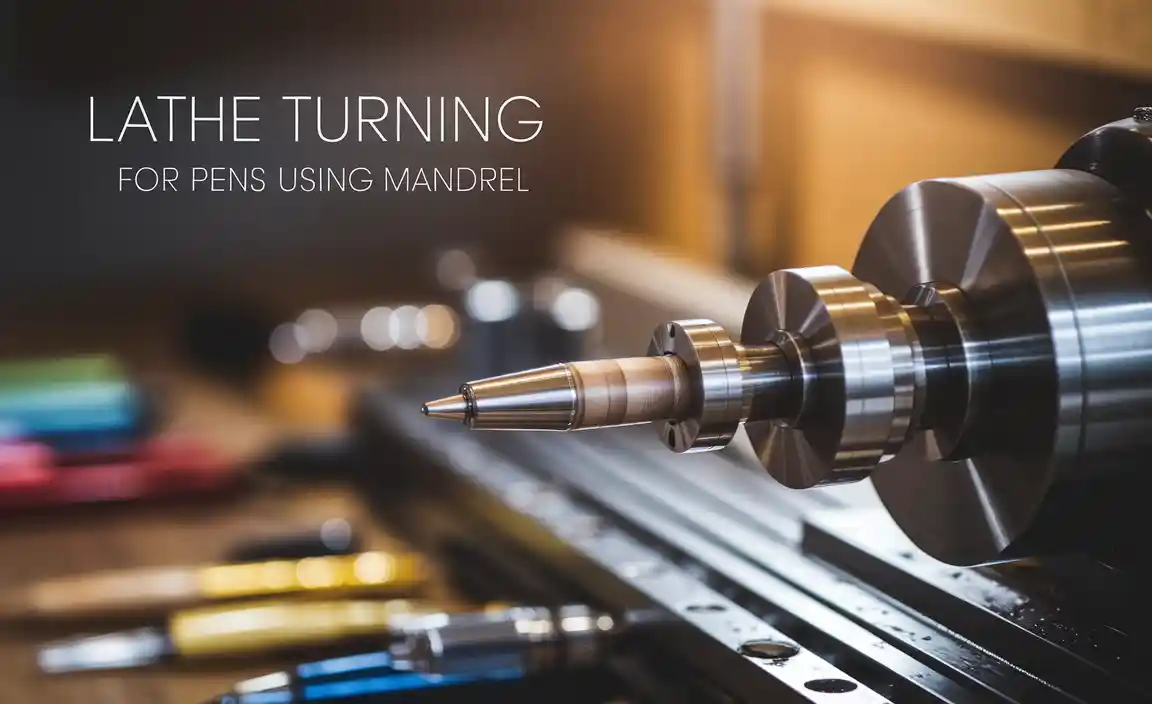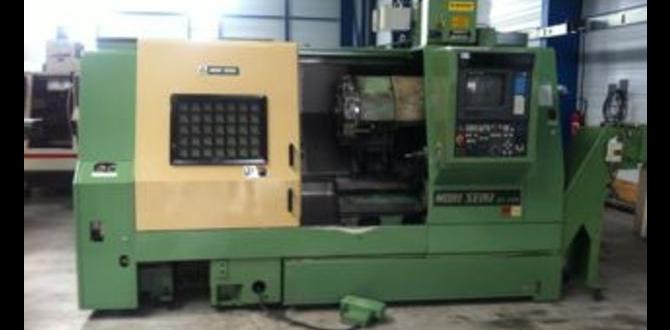A cross slide for a lathe is a fundamental attachment that allows for precise, compound movement of the cutting tool. It enables a machinist to perform complex cuts like tapers, facing, and precise shoulder work by moving the tool in two axes simultaneously or independently. Understanding and using your cross slide effectively is key to unlocking advanced lathe capabilities.
Hey everyone, Daniel Bates here from Lathe Hub! Ever look at a metal lathe and wonder how those amazing, intricate parts are made? A big part of that magic lies with the cross slide. It’s like the second pair of hands for your cutting tool, letting you move it just right. If you’ve felt a bit intimidated by it, or just aren’t sure what it’s really for, you’re in the perfect spot. We’re going to break down what a cross slide is, why it’s absolutely essential, and how you can start using yours with confidence.
We’ll cover everything from its basic anatomy to practical tips and even some common troubleshooting. By the end of this guide, you’ll be ready to tackle all sorts of projects that require more than just simple turning. Let’s get your lathe working smarter, not harder!
What Exactly is a Cross Slide for a Lathe?
Imagine your lathe’s main bed is like a highway. The carriage moves along that highway, carrying your workpiece or tools. Now, think of the cross slide as a smaller, more precise road branching off from that highway. It’s mounted on top of the carriage, and it allows your cutting tool to move sideways (across the lathe’s bed) and towards or away from the tailstock (along the bed’s length).
This dual-axis movement is what makes a lathe so versatile. Without it, you’d only be able to turn simple cylindrical shapes. The cross slide opens up a world of possibilities for shaping and detailing.
Why the Cross Slide is a Lathe’s Secret Weapon
So, why is this attachment so important? It’s all about control and capability. Here’s why it’s a game-changer for any machinist:
- Precision Control: The cross slide, especially with its calibrated dials, gives you incredibly fine control over the tool’s position. This is crucial for achieving exact dimensions and smooth finishes.
- Complex Operations: It’s not just for simple turning. The cross slide is essential for operations like:
- Taper Turning: Creating angled surfaces.
- Facing: Machining flat surfaces on the end of a workpiece.
- Shoulder Making: Creating distinct steps in diameter on a shaft.
- Grooving and Parting Off: Cutting grooves or completely separating a piece.
- Thread Cutting: While often aided by the lead screw, the cross slide provides the critical feed motion.
- Increased Efficiency: For many tasks, using the cross slide is much faster and more accurate than trying to achieve the same result with hand movements or different setups.
- Versatility: It transforms a basic lathe into a more capable machine, suitable for a wider range of projects, from simple hobbyist creations to intricate engineering parts.
Anatomy of the Cross Slide: Key Components
Let’s break down the parts you’ll find on a typical cross slide. Knowing these will help you understand how it works and how to operate it smoothly.
1. Compound Rest
This is the main assembly sitting on top of the cross slide. It’s designed to hold your cutting tool and can usually swivel. The compound rest itself has two axes of movement, controlled by handwheels.
2. Tool Post
Bolted to the compound rest, the tool post is where you firmly clamp your cutting tool. There are different types, like the single-bolt type (common on smaller lathes) and the quick-change tool post (QCTP) which allows for rapid tool changes and adjustments. A secure tool post is vital for safety and accuracy.
3. Cross Slide Handwheel(s)
These are the knobs you’ll turn to move the cross slide. On many lathes, there’s a handwheel for the cross slide (moving it in and out, perpendicular to the bed) and another for the compound rest (moving it along the bed’s axis). These handwheels are usually marked with dials (or “thimbles”) that have fine graduations for precise measurements.
4. Lead Screw and Nut
A lead screw runs along the length of the cross slide. When you turn the cross slide handwheel, it engages a nut mechanism that drives the slide movement along this screw. This is what allows for controlled, repeatable linear motion.
5. Gibs and Adjustments
Gibs are thin strips of metal (often tapered) that sit between the moving parts of the cross slide and the stationary parts. They are used to take up any play or slop in the mechanism. You can usually adjust the tightness of the gibs to ensure smooth, precise movement without excessive looseness, which is critical for accuracy.
6. Dovetail Ways
The cross slide moves along ways (guides) that are typically shaped like a dovetail. This design provides a stable and precise sliding motion. Keeping these ways clean and lubricated is essential for smooth operation and longevity of your lathe.
How the Cross Slide Moves (The Two Axes)
The beauty of the cross slide system is its ability to move your tool in two distinct directions, independent of the main carriage movement along the bed.
- Crossfeed (Z-axis on some machine tools): This is the primary movement that people associate with the “cross slide.” Turning the cross slide handwheel moves the tool in or out, perpendicular to the lathe’s bed. This is what you’ll use for facing operations, cutting shoulders, and for moving the tool to a precise diameter.
- Saddle Feed (X-axis on some machine tools): This movement is controlled by the carriage handwheel and moves the entire carriage (and thus the cross slide) along the length of the lathe bed. This is for turning longer cylindrical surfaces.
- Compound Rest Movement (Usually Y-axis): The compound rest assembly, sitting on top of the cross slide, can also be swiveled. Its handwheel allows the tool to move in or out at an angle relative to the lathe bed. This is crucial for taper turning and can provide very fine longitudinal feed when you need extreme control.
The combination of these movements allows for complex contouring. For example, to cut a taper, you might set the compound rest to an angle and then use its handwheel for the feed along that angle, rather than relying solely on the cross slide or saddle feed.
Getting Started: Attaching and Setting Up Your Cross Slide
For most metal lathes, the cross slide is a permanent fixture on the carriage. However, if you are setting up a new lathe or have had to remove it for maintenance, here’s a general idea of how it attaches. For many hobbyists or woodworkers, the “cross slide” might refer to a specialized attachment like an indexing head or a grinding attachment that mounts to the compound rest, which itself sits on the cross slide.
Assuming you’re talking about the standard cross slide assembly attached to the carriage:
- Cleanliness is Key: Ensure all mating surfaces on the carriage and the cross slide base are meticulously clean. Any debris can cause damage or prevent proper alignment. Refer to your lathe’s manual for specific cleaning procedures.
- Align Dovetails: The dovetail ways on the bottom of the cross slide need to precisely mate with the dovetail ways on the top of the carriage. Carefully slide the cross slide onto the carriage ways.
- Install Gibs: The tapered gibs are often installed at this stage or already in place. They help lock the sliding components together snugly.
- Secure with Bolts: There will be securing bolts that pass through the carriage and thread into the cross slide base, or vice-versa. Tighten these bolts evenly to secure the cross slide to the carriage.
- Check for Smoothness: Once secured, gently try to move the cross slide (and carriage) by hand. It should move smoothly without binding or excessive play.
- Adjust Gibs: If there’s too much play, you’ll need to adjust the gibs. This usually involves loosening a locking screw and then tapping or adjusting a set screw that moves the gib, tightening the fit. If it’s too tight, you’ll do the opposite. This is a crucial step for accuracy. Small movements should feel precise, not sloppy or stiff.
- Lubricate: Apply appropriate machine oil to the ways and moving parts. This is essential for preventing wear and ensuring smooth operation. Consult your lathe’s manual for recommended lubricants. Reliable lubrication is a hallmark of good machining practice.
For Wood Lathes: If you’re working with a wood lathe, the term “cross slide” might refer to specialized attachments that bolt onto the tool rest holder. These offer similar multi-axis movement for finer control in detailed wood carving or shaping. The setup will involve clamping these attachments securely to your existing tool rest post.
Using Your Cross Slide for Common Operations
Let’s get practical. Here’s how to use your cross slide for some everyday machining tasks.
1. Facing Operations
Facing is creating a flat surface at the end of your workpiece. It’s essential for making parts square and achieving specific lengths.
- Secure the Workpiece: Mount your workpiece firmly in the chuck.
- Position the Tool: Mount a suitable facing or turning tool in the tool post. Position it so it’s at the center height of the work. Bring the tool just to the edge of the workpiece.
- Set Zero on the Dial: With the tool touching the outer edge of the workpiece, return the cross slide handwheel to the “zero” mark on its dial. If it doesn’t have a zero, make a note of the starting position.
- Engage Crossfeed: Advance the tool using the cross slide handwheel. Aim for controlled, light cuts. Move the tool from the outer edge towards the center of the workpiece.
- Adjust Depth of Cut: For each pass, you’ll advance the tool slightly using the cross slide handwheel for the depth of cut. Clean up the surface with a finishing pass.
- Check Diameter: Use a caliper to measure the diameter and ensure it’s as intended. The cross slide dial will tell you how much diameter you’ve removed (since each unit of movement on the cross slide dial relates to half that amount on the diameter).
2. Turning to a Specific Diameter
This is for creating accurate cylindrical diameters.
- Set Tool Height: Mount your turning tool and set its cutting edge to the center height of the workpiece.
- Position the Tool: Bring the tool to the end of the stock that you want to turn down.
- Zero the Dial: Touch the tool lightly to the stock and set the cross slide dial to zero. (Or note the starting position).
- Engage Saddle Feed: Use the carriage handwheel to move the tool along the length of the workpiece, taking off material. This is the primary “turning” motion.
- Use Cross Slide for Diameter: To reduce the diameter, you will use the cross slide handwheel to advance the tool into the cut. Each “thou” (0.001 inch) you move with the cross slide handwheel will reduce the diameter by two “thou.”
- Monitor and Measure: Take light cuts and frequently measure the diameter with a caliper. Adjust the cross slide handwheel incrementally until you reach your target diameter.
3. Cutting Shoulders
A shoulder is a sudden change in diameter on a shaft.
- Turn to Larger Diameter: First, turn the main part of the shaft to its desired larger diameter using the carriage feed.
- Position for Shoulder: Move the carriage so that the tool is positioned precisely where the shoulder should be.
- Engage Cross Slide: Use the cross slide handwheel to feed the tool into the workpiece, creating the step. You might want to face the end of the smaller diameter after creating the shoulder.
- Consider Relief Grooves: For cleaner shoulders, especially with tool bits that have a radius, it’s often a good idea to cut a small relief groove at the base of the shoulder using a grooving tool or the tip of your turning tool before facing.
4. Taper Turning
Creating an angled surface. There are a few methods, but using the compound rest is common for moderate tapers.
- Calculate Angle: Determine the angle of the taper you need. For example, a 1-inch long taper that goes from 1-inch diameter to 1.5-inch diameter requires an angle. You can then set your compound rest to this angle (or 90 degrees minus this angle, depending on how you orient it).
- Loosen and Swivel: Loosen the base of the compound rest (usually with locking bolts) and swivel it to the calculated angle. Re-tighten the locking bolts securely.
- Position Tool: Mount your cutting tool. Position it at the starting point of the taper.
- Use Compound Rest Handwheel: Advance the tool along the angle using the compound rest handwheel for your feed. The cross slide and saddle are often locked or not used for the primary taper cutting motion.
- Alternative: Offset Tailstock Method: For long, gentle tapers, moving the tailstock off-center can also create a taper as the carriage moves linearly but the cutting tool follows the angled path due to the offset. This method uses the saddle feed.
Cross Slide Dial Readings: What They Mean
The dials on your cross slide handwheel are your measurement gauges. They are absolutely crucial for accuracy.
- Standard Dial Graduation: On most lathes, one full revolution of the cross slide handwheel will move the tool a specific distance. This is often 0.100 inches (or a similar metric value).
- Markings: The dial face will have markings. Each major mark might represent 0.010 inches, and there are usually smaller ticks for thousandths of an inch (or tenths of a millimeter).
- Diameter vs. Radius: Remember, when turning, a movement of 0.001″ on the cross slide dial results in a change in diameter of 0.002″ because the tool is cutting from both sides simultaneously (conceptually). So, if you want to reduce the diameter by 0.020″, you need to move the cross slide by 0.010″ on its dial.
- Setting Zero: Always set your dial to zero at a known point (like touching the workpiece) before starting a measured cut. This ensures your measurements are relative to that starting point.
Understanding these readings allows you to cut to precise diameters and depths without constant caliper use, becoming quite proficient with practice.
Maintenance and Care for Your Cross Slide
A well-maintained cross slide will perform better, last longer, and give you more accurate results. Here are some essential tips:
- Keep it Clean: After every use, wipe down the ways, lead screw, and moving parts. Remove chips, dust, and any stray debris. A stiff brush and a clean rag are your best friends.
- Lubricate Regularly: Apply a light machine oil (like way oil or even 3-in-1 oil for lighter use) to the ways and screw mechanisms frequently. Check your lathe’s manual for recommended lubricant types and intervals. Proper lubrication, like that discussed by the Occupational Safety and Health Administration (OSHA) on mechanical power transmission safety, emphasizes keeping machinery in good working order to prevent accidents and wear.
- Check Gib Adjustments: Periodically check for play in the cross slide. If it feels loose, adjust the gibs. Too much play leads to inaccurate cuts and can chatter.
- Inspect for Damage: Look for any nicks, burrs, or signs of wear on the ways or the lead screw. Address any issues promptly.
- Protect from Rust: If your lathe is in a humid environment, consider wiping down exposed metal parts with a rust-inhibiting oil to prevent corrosion.
Table: Common Cross Slide Issues and Solutions
Here’s a quick reference for troubleshooting common problems you might encounter with your lathe’s cross slide:
| Problem | Possible Cause | Solution |
|---|---|---|
| Stiff or difficult movement | Lack of lubrication; Dirt or debris on ways; Gibs too tight | Clean ways and lubricate; Adjust gibs to be slightly looser |
| Excessive play or slop | Gibs are too loose; Worn ways or lead screw | Adjust gibs to tighten the fit; Inspect for wear, may need adjustment or replacement of parts |
| Inaccurate cuts (not |




